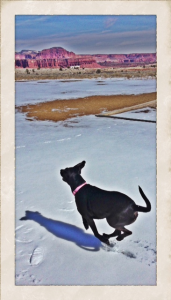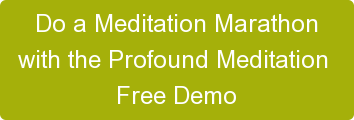Under Intense Stress? Do a Brainwave Entrainment Meditation Marathon
 It’s the last day of a five-week Integral Recovery intensive and I feel really good about it. There was a lot of healing, a lot of practice, and people are at a different place from where they started. We did a lot of work: We meditated an hour every morning and 40 minutes every evening. Then we journaled and shared about what came up during our meditations. We worked out really hard together physically, strength training, doing yoga, playing tennis—all kinds of stuff. It was intense. When you get into the one hour and 40-minute range of doing brainwave entrainment meditation every day, it’s a lot, and it pushes you hard.
It’s the last day of a five-week Integral Recovery intensive and I feel really good about it. There was a lot of healing, a lot of practice, and people are at a different place from where they started. We did a lot of work: We meditated an hour every morning and 40 minutes every evening. Then we journaled and shared about what came up during our meditations. We worked out really hard together physically, strength training, doing yoga, playing tennis—all kinds of stuff. It was intense. When you get into the one hour and 40-minute range of doing brainwave entrainment meditation every day, it’s a lot, and it pushes you hard.
Sometimes we need to, or feel called to, do extra work—extra meditation—maybe go on a personal retreat. I used to go to a monastery near Aspen, Colorado every year for four or five days to do my own individual retreat. I would meditate for three or four hours a day, and I’d read sacred texts or spiritual books, and do a lot of journaling—very, very powerful stuff. I think it’s good to know that you can have your daily practice, but you can also intensify it at times.
I don’t think I was the first person to ever figure this out, but what really helped me in my recovery from depression was the two-hour meditation. When I first started to meditate for that long, I was coming out of the deep darkness of my own despair and depression. Some days I would even meditate for three or four hours at a time. Of course, that was before the advent of the Profound Meditation Program. There was good brainwave entrainment technology available at the time, but it wasn’t nearly as strong as what we’ve been producing at iAwake Technologies. Now you can get the same effect meditating for two hours that you used to get in three or four hours.
If you’re going through a period of intense stress, emotional disruption, or if you’re in recovery and you’re getting pissed off and starting to crave (getting a case of the F___ it!s), and you’re thinking of picking up the bottle again, or whatever, just do the meditation. Your ego won’t want to do it, because often when you sink into a prolonged meditation, it really brings stuff up. It will intensify the anger, the depression, whatever the feelings are, before you give them permission to do their thing, and then they release.
This is a very powerful technique, and it’s always worked for me. Sometimes it’s not instantaneous, but most of the time it is. In the process of the prolonged meditation, stuff simply releases. I remember just a few weeks ago, I was going through some turmoil. I can’t remember what it was, but it was pretty painful. I woke up in the morning after having done a lot of meditation the day before, and it was just gone. It must have released in my sleep or something. I was amazed to find myself clear.
So, a two- or three-hour brainwave entrainment “meditation marathon” should really do it. Often, I’ll do an hour and ten minutes, say the Digital Euphoria: Special Edition,and that just about takes care of it most of the time, whatever the issues are, or the turmoil. With time and practice, we learn that negative emotions, feelings, and fear—all these bodily sensations that come up—are to be invited in, as Rumi said, as honored guests, because they can sweep our house clean and open us up.
Emotions aren’t there to be fixed:
- We don’t need to fix them.
- We don’t need to medicate them.
- We don’t need to stuff them in the oven or the basement.
- We don’t need to project them on other people.
- We just need to allow them to do whatever they need to, held in the context of the Witness.
Witnessing is not just stepping outside—the Witness can step right inside the middle of it and just let it do its thing, do its feelings, and watch the thought forms. You don’t want to get caught up in the thoughts, because if you get too attached to the thoughts and their messages before the release happens, they can get you stuck like a rat on a wheel. Thoughts like, “It’s my fault.” “I deserve this.” So, don’t get caught up in your thoughts. Just bracket the thoughts and stay with the feelings.
As Alice Miller says in the title of her book, The Body Never Lies. Our interpretations of what the body says are often skewed, but the body is always giving us information. It’s amazing how many of us are, well, schizoid! We’re split off from our bodies. We live in our heads, and we don’t deal with the feelings because we’re scared. We say, “Oh, that’s painful. That’s bad.” We don’t realize that dealing with the feelings is the path of healing—bringing the heart and the body back online and connected with the awakened mind. It’s always somatic when you’re dealing with emotional stuff, when you’re dealing with trauma, when you’re dealing with PTSD.

One of the truly breakthrough capacities of this type of brainwave entrainment meditation (the Profound Meditation Program) is that it is an aide in uniting the body and the mind and in releasing trauma that is stored in the body. As Peter Levine says, PTSD is not a psychological problem, it is a biological probelm. One can meditate traditionally for years, and this stuff will simply not come up. I think this is why we have so many meditation masters and gurus, who are masters of traditional meditation and emptiness, but who behave monstrously in their communities, abusing their power and influence in ways that are often nearly unimaginable. This is because their traditional meditation does not get to the shadow.
The more you do the brainwave entrainment meditation practice, the more you begin to really tune in to your body—the subtle energies and all of the sensations and emotions. This then becomes a path of awakening, a path of integration and wisdom.It’s really extraordinary.
___________________________________________________________________________
Adapted from iAwake Technologies’ free, weekly teleconference call on May 8, 2013.
Join our weekly calls!
To receive information on how to join the weekly iAwake coaching calls that John leads, sign up for the free meditation download and you’ll be put on the email list. You can also access the phone-in information on our Teleseminar page.
___________________________________________________________________________
 John Dupuy is the CEO of iAwake Technologies and the founder of Integral Recovery, a holistic addiction treatment approach inspired by Ken Wilber’s Integral Model. He is also the author of Integral Recovery: A Revolutionary Approach to Alcoholism and Addiction, recently published by SUNY Press. As a pioneer in the use of brainwave entrainment in therapy and personal development, John has dedicated his life to helping others deepen their spiritual practice and transform their lives.
John Dupuy is the CEO of iAwake Technologies and the founder of Integral Recovery, a holistic addiction treatment approach inspired by Ken Wilber’s Integral Model. He is also the author of Integral Recovery: A Revolutionary Approach to Alcoholism and Addiction, recently published by SUNY Press. As a pioneer in the use of brainwave entrainment in therapy and personal development, John has dedicated his life to helping others deepen their spiritual practice and transform their lives.
___________________________________________________________________________
Leave a Comment
You must be logged in to post a comment.


Leave your comments below